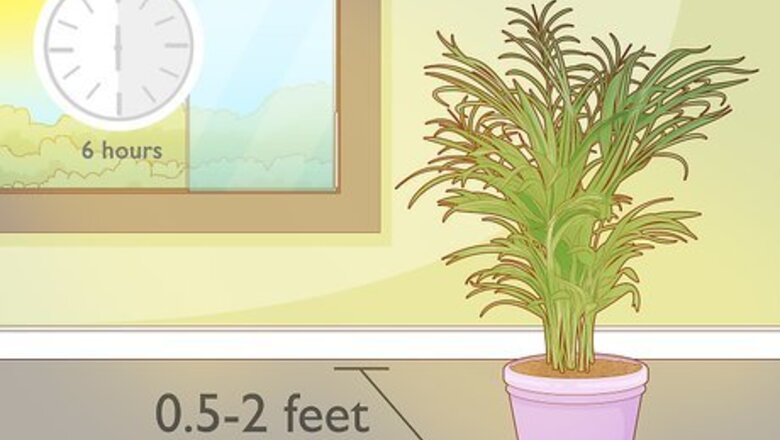
views
Creating the Ideal Environment
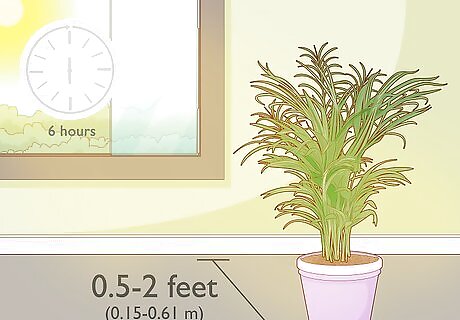
Place your palm next to a window that gets 6 hours of direct sunlight. Most species of palm tree require a lot of sunlight. Set your palm tree 0.5–2 feet (0.15–0.61 m) away from a large window in your home that gets a lot of sun.Tip: For most palm trees, a lack of light is the strongest contributing factor to a lack of growth. A healthy palm tree requires a lot of direct sunlight, so give them as much as you possibly can. If you don’t have a well-lit room in your home that has large windows, it may be kind of tough to keep your palm healthy when it gets bigger. Parlor palms are the major exception when it comes to sunlight requirements. Parlor palms will do just fine in indirect light and can be kept 5–10 feet (1.5–3.0 m) away from sunny windows. Some species of palm tree, like the Kenita palm, sentry palm, and pygmy palm will do just fine with 2-4 hours of direct sunlight. Many people keep their potted palms outdoors during the summer months to ensure that it gets enough light and heat. You can keep a potted palm tree outside permanently if you live in a tropical area, but be sure to bring it inside during periods of excessive rain.
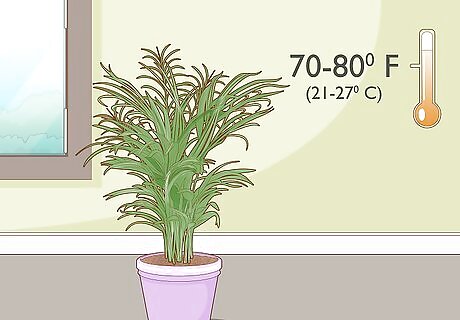
Keep the temperature between 70–80 °F (21–27 °C) during the day. At night, palm trees thrive when it’s around 65 °F (18 °C). During the day, most palm tree species prefer 70–80 °F (21–27 °C). Adjust your thermometer before going to bed to ensure that your palm gets time to cool down at night. Since your palm tree needs to be near a window, it can get drafty if it gets cold out. During winter months, keep the window near your palm sealed with plastic wrap and tape to prevent freezing your palm tree. If your home regularly gets colder than 65 °F (18 °C), the Kentia palms and European fan palms are great choices. They tend to be much more comfortable with lower temperatures than other palms. If the tree starts listing at an angle, it’s likely due to a draft or uneven temperature. Continue adjusting the palm tree’s location until you find a healthy location for your tree.
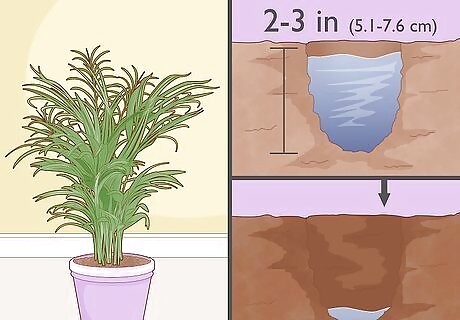
Test the soil to ensure that it’s well-draining and replace it as needed. Dig a small 2–3 in (5.1–7.6 cm) hole in the soil with your finger or a spoon. Fill this hole with water. If it takes less than 10 minutes for the water to soak into the rest of the soil, your soil is well-drained. If it takes more than 10 minutes, replace the soil slowly over 1-2 weeks with an organic mix of peat moss, bark, and sandy soil.Tip: If you do need to replace the soil, do not change it out all at once. Use a trowel to scoop out 20-30% of the soil and replace it little by little over the course of several days. Continue doing this until the majority of your old soil is gone. Well-draining soil refers to soil compositions that won’t cause water to pool up. Almost every potted palm tree you see at a nursery or store will already have well-draining soil, but it’s important that you keep the soil well-draining over the palm’s life. Palm trees are prone to root rot. If water pools up in the soil, it can increase the odds that the roots begin to rot. Well-draining soil ensures that the water doesn’t stick around for too long in your pot.
Watering Your Tree
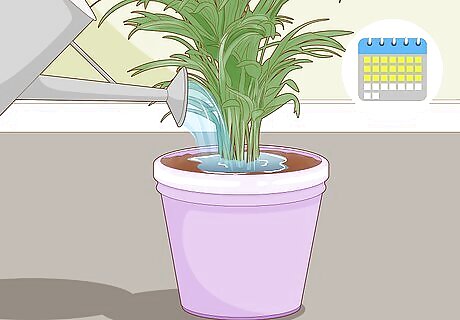
Drench the palm's roots thoroughly with water every 2-3 weeks. The amount of water your palm tree needs depends on its species and size. Generally speaking, the larger the palm, the more water you need. Water your palm outdoors and pour 0.5–4 gallons (1.9–15.1 L) around the base of the plant until the soil is thoroughly soaked. Give the water 30-60 minutes to drain before taking the plant indoors. Most palm trees only require water every 2-3 weeks.Tip: Palm trees can be kind of heavy once they get big. Keep your palm tree on a saucer with wheels to make it easier to roll outside when you need to water it. This is a major reason why people tend to keep palm trees on the main floor of their home! Some palm trees are sensitive to chlorine and other nutrients in tap water. If your palm hates tap water, leave a bucket of water out at least 24 hours before watering your palm to give the nutrients and chlorine time to evaporate.

Let the soil dry out completely before drenching the roots again. Some palm trees do not typically require frequent watering. Wait for the soil to dry out completely before you take the palm back outside for another watering. To check the dryness, stick your finger 3–4 inches (7.6–10.2 cm) into the soil. If the soil feels moist, your tree doesn’t need more water. If the soil is totally dry and brittle, it’s time to water your palm again. Indoor palms require less water than palm trees that are grown outside. This is due to the fact that potted soil typically retains water for much longer than the soil outside. Some species of palm tree require more water than others. If your palm’s soil dries out after 2-3 days, your specific tree may require several watering sessions a week.
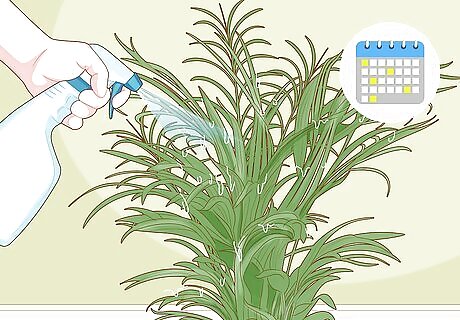
Mist your palm tree’s leaves once a week to keep them humid. While the soil needs to dry out before you water your plant again, the leaves should basically always be moist. Fill a spray bottle up with distilled water and leave it near your plant. Once a week, mist the leaves of your palm tree to ensure they retain some moisture. If you prefer, you can set a humidifier up next to your palm tree and leave it on. A humidifier will typically provide enough moisture for the leaves and you can skip the spray bottle.

Cut back on water and change the soil if the leaves begin turning brown. If your palm tree’s leaves begin to turn brown at the tips, your plant is getting too much water and the soil is too humid. Use a trowel to remove most of the soil and discard it. Replace 50% of the container with a dry, well-drained soil. Then, wait 2-3 weeks to see if the leaves bounce back before watering your plant again.
Managing Growth
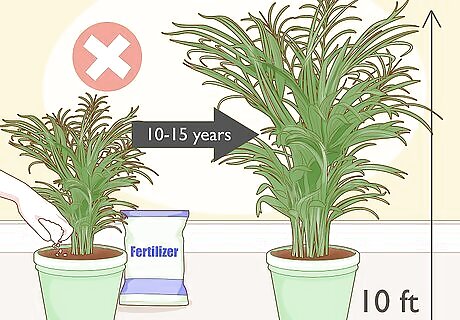
Avoid fertilizer to ensure that your palm grows slowly. You cannot trim a palm tree down vertically if it grows too tall for your home, and most palm trees will wither or die if you cut the trunk back. To ensure that it doesn’t grow too quickly, avoid using fertilizer. Most palm trees will do just fine without it, and fertilizer can trigger growth spurts and make your palm tree too tall for your home. Even if it is a shorter variety, rampant growth may block out your window or overrun the space in your home.Tip: You want your palm tree to grow, just not too quickly. The goal in avoiding fertilizer is not to stunt growth completely, simply to slow it down. When they’re juveniles, it will typically take most palm trees 10-15 years to grow 10 feet (3.0 m) tall. Some species will never exceed 10 feet (3.0 m) in height. This is less of a concern for species that don’t grow taller than 5–6 feet (1.5–1.8 m). The sago palm is an exception to this rule. Sago palms, which aren’t technically palm trees but look identical to many of them, tend to require fertilizer.
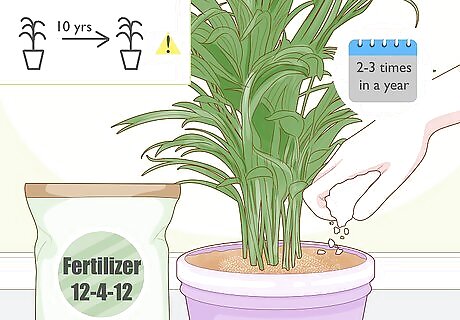
Provide organic fertilizer 2-3 times a year if your palm isn’t growing. If your palm tree is struggling to grow and doesn’t seem like it’s getting bigger, pour a handful of an organic fertilizer over the soil and work it in by hand. A 12-4-12 or 8-2-12 mix with iron, manganese, zinc, and copper will work well. Do this once every 3-4 months to ensure that your palm tree continues to develop. Avoid fertilizers that are high in nitrogen. These fertilizers can cause palm trees to grow too rapidly. Some palm trees will require 2-3 doses of fertilizer a year for their entire lifespan. This is typically necessary for palm trees that don’t grow taller than 15 feet (4.6 m) when they’re outside.
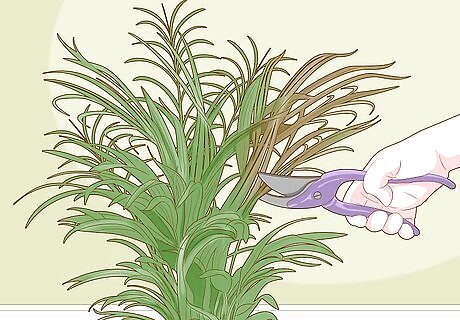
Prune your palm tree by removing dead leaves as needed. As your palm tree grows over time, some of the leaves may struggle to get enough sun and water. Use shears to trim these leaves off to keep the rest of your plant happy and healthy. It may be 1-2 years before you need to do this. Some palms that develop a lot of leaves will require a lot of pruning. Other species will require almost no pruning at all. You cannot prune the trunk of the tree. Do not cut or trim this portion of the plant.
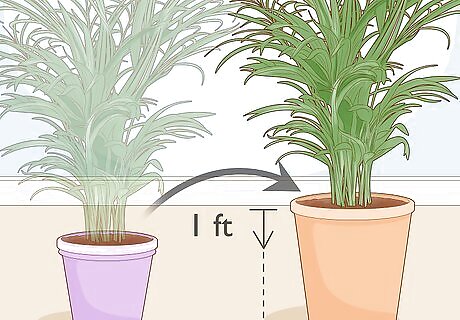
Repot your tree if the roots grow too large for your container. If the roots grow too big for their pot, transfer the tree’s contents in the spring or early summer. Dig out the soil and carefully pull the roots out of the pot without cutting or breaking them. Set them in a new pot that is at least 1 ft (0.30 m) deeper and wider than your previous pot before adding the soil. The roots will begin sticking out of the soil when they’re growing too large. This typically won’t happen until 2-3 years of continuous growth have occurred. Be extremely careful when doing this. If you break a lot of the roots, your palm tree may struggle to reestablish itself in its new pot. Palm trees tend to grow to fit the container they’re in. If you use a massive pot for a small tree, it’s more likely to grow taller quickly.

Watch out for mites and mealybugs and treat your plant as needed. When it comes to palm trees, mites and mealybugs are the 2 most common pests. If your leaves begin to wilt, turn yellow, and you see web-like residue on your trunk, you may have mites. Mealybugs will leave a white moldy material behind on the trunk and bit the base of your tree’s leaves. Quarantine affected plants in an isolated area outside and spray the tree with horticultural oil or neem oil every 7-14 days to kill the bugs. Palm trees are typically pretty safe inside. Mealybugs and mites are extremely unlikely to wander indoors, but they may attack your plant if you take it outdoors for the summer. Horticultural and neem oil are natural insecticides that won’t harm your plant. They cover the surface of the plant and suffocate any pests.












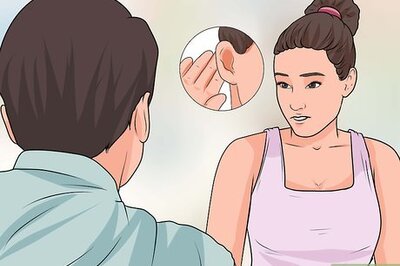







Comments
0 comment